Contract bridge
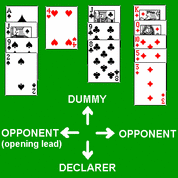
Bryanna Chrisp-
Contract Bridge became extremely common amongst card players across the nation in 1926. Harold Vanderbilt issued 125 regulations for playing the game properly. The traditional style of bridge was abandoned for decades to come; a new method was in vogue.
(http://www.pagat.com/boston/bridge.html)
Contract Bridge became extremely common amongst card players across the nation in 1926. Harold Vanderbilt issued 125 regulations for playing the game properly. The traditional style of bridge was abandoned for decades to come; a new method was in vogue.
(http://www.pagat.com/boston/bridge.html)
pulp magazines
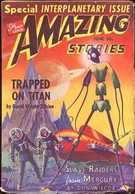
Bryanna Chrisp-
Pulp mazines were published using paper derived from wood pulp. Pulp magazines were conveniently priced magazine catering to an audience of science-fiction lovers. In 1926, the trend climaxed and magazines such as The Amazing Stories Magazine became household reading material. (http://www.magicdragon.com/UltimateSF/timeline.html) http://www.centennialofflight.gov/essay/Social/space_lit/SH10.htm
Pulp mazines were published using paper derived from wood pulp. Pulp magazines were conveniently priced magazine catering to an audience of science-fiction lovers. In 1926, the trend climaxed and magazines such as The Amazing Stories Magazine became household reading material. (http://www.magicdragon.com/UltimateSF/timeline.html) http://www.centennialofflight.gov/essay/Social/space_lit/SH10.htm
speakeasies

Bryanna Chrisp
Speakeasies obtained their nickname because of the necessity for secrecy from government officials. They were designated for the illegal sale of alchoholic beverages during the Prohibition era. It is estimated that throughout the Prohibition era, over 100,000 speakeasies existed in the City of New York. Many city officials were givin monetary compensation from speakeasy owners in exchange for complacisent when alchohol was being transported to, delivered, and sold at their speakeasy.
(http://alliance.ed.uiuc.edu/cdrom/hononegah/prohibition/speakeasies-s.htm)
(http://www.legendsofamerica.com/ah-prohibitionspeakeasy.html)
Speakeasies obtained their nickname because of the necessity for secrecy from government officials. They were designated for the illegal sale of alchoholic beverages during the Prohibition era. It is estimated that throughout the Prohibition era, over 100,000 speakeasies existed in the City of New York. Many city officials were givin monetary compensation from speakeasy owners in exchange for complacisent when alchohol was being transported to, delivered, and sold at their speakeasy.
(http://alliance.ed.uiuc.edu/cdrom/hononegah/prohibition/speakeasies-s.htm)
(http://www.legendsofamerica.com/ah-prohibitionspeakeasy.html)
electric trains
Nicolette Tosunian-
Made of wood, tinplate, cast iron, or brass, early toy trains were either operated manually or by hand, clockwork, or simple spring mechanisms. Handmade live-steam locomotives were introduced in Europe after the mid-19th century. Steam locomotives and antique toy trains were subsequently mass-produced in the United States by such firms as Garlick, Eugene Beggs, and Weeden well into the 1920s. Among the many firms that manufactured tinplate clockwork trains were Brown, Schlesinger, Fallows, and the company Althof, Bergmann.
(http://www.antique-antiques.com/antique-toy-trains.shtml)
Made of wood, tinplate, cast iron, or brass, early toy trains were either operated manually or by hand, clockwork, or simple spring mechanisms. Handmade live-steam locomotives were introduced in Europe after the mid-19th century. Steam locomotives and antique toy trains were subsequently mass-produced in the United States by such firms as Garlick, Eugene Beggs, and Weeden well into the 1920s. Among the many firms that manufactured tinplate clockwork trains were Brown, Schlesinger, Fallows, and the company Althof, Bergmann.
(http://www.antique-antiques.com/antique-toy-trains.shtml)
teddy bear pop
Nicolette Tosunian-
The first twenty years of the 20th century saw the introduction of the Teddy Bear, the Raggedy Ann Doll, and Crayola Crayons, merely advancements of existing popular toys; dolls and drawing materials. Parents who had grown up in the waning years of the 19th century still handed down handmade dolls and wood toys to their children, so companies merely thought of exciting new ways to present that style of toy. In the 1920s, it was more of the same. However, something else happened midway through that prosperous decade. Technology and Pop Culture exploded beyond the scope of anything anyone else had ever seen, making it possible for everyone in the country to listen to the same show on the radio or watch the same stars in film, or drive the same vehicle down the road.
(http://www.thepeoplehistory.com/toys.html)
The first twenty years of the 20th century saw the introduction of the Teddy Bear, the Raggedy Ann Doll, and Crayola Crayons, merely advancements of existing popular toys; dolls and drawing materials. Parents who had grown up in the waning years of the 19th century still handed down handmade dolls and wood toys to their children, so companies merely thought of exciting new ways to present that style of toy. In the 1920s, it was more of the same. However, something else happened midway through that prosperous decade. Technology and Pop Culture exploded beyond the scope of anything anyone else had ever seen, making it possible for everyone in the country to listen to the same show on the radio or watch the same stars in film, or drive the same vehicle down the road.
(http://www.thepeoplehistory.com/toys.html)
lincoln logs
Nicolette Tosunian-
Lincoln Logs were first produced in 1916 by company founder John Lloyd Wright, son of architect Frank Lloyd Wright. Records show that the J. L. Wright Company of Chicago, Illinois, obtained its patent for the design on August 31, 1920 and had the Lincoln Logs name registered on August 28, 1923. Building logs of similar designs had been produced by several other toy companies since the civil war but John L. Wright's version was very successful from the beginning and has remained so to this day. His design was copied, and some say improved upon, by the Halsam Products Company, also of Chicago, with their American Logs. In 1943, the company was sold to Playskool who makes the building sets today.
(http://www.oldwoodtoys.com/lincoln_logs.htm)
Lincoln Logs were first produced in 1916 by company founder John Lloyd Wright, son of architect Frank Lloyd Wright. Records show that the J. L. Wright Company of Chicago, Illinois, obtained its patent for the design on August 31, 1920 and had the Lincoln Logs name registered on August 28, 1923. Building logs of similar designs had been produced by several other toy companies since the civil war but John L. Wright's version was very successful from the beginning and has remained so to this day. His design was copied, and some say improved upon, by the Halsam Products Company, also of Chicago, with their American Logs. In 1943, the company was sold to Playskool who makes the building sets today.
(http://www.oldwoodtoys.com/lincoln_logs.htm)
isolationism
Nicolette Tosunian-
Indeed, isolationism would persist for a few more decades. During the 1920s, American foreign affairs took a back seat. In addition, America tended to insulate itself in terms of trade. Tariffs were imposed on foreign goods to shield U.S. manufacturers. During the 1920s and 1930s, the preponderance of Americans remained opposed to enmeshment in Europe's alliances and wars. Isolationism was solid in hinterland and small-town America in the Midwest and Great Plains states, and among Republicans.
(http://www.u-s-history.com/pages/h1601.html)
Indeed, isolationism would persist for a few more decades. During the 1920s, American foreign affairs took a back seat. In addition, America tended to insulate itself in terms of trade. Tariffs were imposed on foreign goods to shield U.S. manufacturers. During the 1920s and 1930s, the preponderance of Americans remained opposed to enmeshment in Europe's alliances and wars. Isolationism was solid in hinterland and small-town America in the Midwest and Great Plains states, and among Republicans.
(http://www.u-s-history.com/pages/h1601.html)
jazz Suits
Roman. (0) )
During the 1920's the appropriate wear of the day was the standard suit, either single or double breasted. Jazz musicians on the other hand decided that, the style was too bland and chose to wear tight suits, with long vests, with pants "stove pipe skinny."http://www.murrayonhawaii.com/nolan/fashionhistory_1920mens.html
During the 1920's the appropriate wear of the day was the standard suit, either single or double breasted. Jazz musicians on the other hand decided that, the style was too bland and chose to wear tight suits, with long vests, with pants "stove pipe skinny."http://www.murrayonhawaii.com/nolan/fashionhistory_1920mens.html
Pogo STicks
Roman. (0) )Although pogo sticks were created in 1919 they came to the U.S in 1920. The pogo stick was promoted by the New York Hippodrome chorus girls who performed an entire show on the pogo sticks. The sticks took New York by storm, with competitions similar to dance marathons and events held for the breaking of world records.
http://www.pogostickusa.com/history.htm
http://www.pogostickusa.com/history.htm
trading cards
Roman. (0) )
With the creation of "W strip" cards, baseball cards were now being sold as a separate good. The cards would come in a sheet of eight ten or twenty and be cut by whoever purchased them,. The problem with this is usually little kids would buy Babe Ruth's and cut the edges horribly. Also this was one of the major turning points in card popularity because Babe Ruth's card became mass produced; which attracted more buyers.
http://instruct.westvalley.edu/peltz/bbcards.html
With the creation of "W strip" cards, baseball cards were now being sold as a separate good. The cards would come in a sheet of eight ten or twenty and be cut by whoever purchased them,. The problem with this is usually little kids would buy Babe Ruth's and cut the edges horribly. Also this was one of the major turning points in card popularity because Babe Ruth's card became mass produced; which attracted more buyers.
http://instruct.westvalley.edu/peltz/bbcards.html
Goldfish swallowing
Roman. (0) )
Apparently originating from a drink recipe, from the prohibition era where gold flakes were involved in a cocktail; people have taken it out of context and later actually swallowed goldfish. Poor Nemo.
http://articles.sfgate.com/2004-07-22/wine/17435986_1_drink-goldfish-cocktail-professor
Apparently originating from a drink recipe, from the prohibition era where gold flakes were involved in a cocktail; people have taken it out of context and later actually swallowed goldfish. Poor Nemo.
http://articles.sfgate.com/2004-07-22/wine/17435986_1_drink-goldfish-cocktail-professor
Gambling
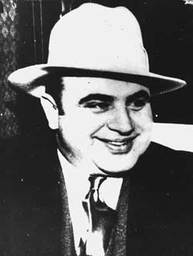
Bryanna Chrisp-
Along with the prohibited activities such as drinking, gambling was fround upon by government as well as conservative political groups. For those willing to drink and attend speakeasies, gambling was an addition to the taboo extravaganza. Crime lords such as Al Capone were associated with and made astounding revenue from gambling establishments. ( http://www.mixgaming.com/casino-gambling-in-the.html)
(http://www.srpublications.com/criminology/item/a/al_capone.htm)
Along with the prohibited activities such as drinking, gambling was fround upon by government as well as conservative political groups. For those willing to drink and attend speakeasies, gambling was an addition to the taboo extravaganza. Crime lords such as Al Capone were associated with and made astounding revenue from gambling establishments. ( http://www.mixgaming.com/casino-gambling-in-the.html)
(http://www.srpublications.com/criminology/item/a/al_capone.htm)
RollerSkating
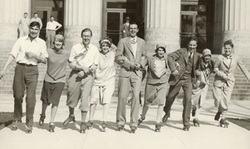
Caitlin Stryker
When car production rose, so did the need for more surfaced roads and with it the popularity of rollerskating exploded, at least with the young folks. Youths were so frequently on the roads that many merchants thought they scared away customers while motorists considered them a hazard. Sometimes skaters would barely evade oncoming vehicles and fequently these encounters drew choice words from both sides. In March 1923, The Millville Republican, declared roller skaters "a serious menace to business, public safety and the general welfare" of that city, urged merchants to group together in protest.
(http://www.thedailyjournal.com/article/20090403/NEWS01/90406038/Pop-culture-history-Roller-skating-craze-1920s-)
When car production rose, so did the need for more surfaced roads and with it the popularity of rollerskating exploded, at least with the young folks. Youths were so frequently on the roads that many merchants thought they scared away customers while motorists considered them a hazard. Sometimes skaters would barely evade oncoming vehicles and fequently these encounters drew choice words from both sides. In March 1923, The Millville Republican, declared roller skaters "a serious menace to business, public safety and the general welfare" of that city, urged merchants to group together in protest.
(http://www.thedailyjournal.com/article/20090403/NEWS01/90406038/Pop-culture-history-Roller-skating-craze-1920s-)
Reese's PeanutButter Cups
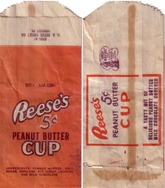
Caitlin Stryker
Harry Burnett Reese was born in 1879 on a farm in Frosty Hill, Pensylvania. He was a former dairy employee working for Milton S. Hershey, founder of the Hershey’s Food Corporation. Inspired by Hershey’s success, H. B. Reese left the dairy started his own confectionery business and in the mid 1920's he hit paydirt. Reese’s Peanut butter chocolate was first manufactured in America in the 1920s when H. B. Reese’s Candy Company introduced a specially processed peanut butter filling with Hershey’s chocolate. The peanut butter cups were the first to be produced and quickly skyrocketed in popularity.
(http://www.articlesbase.com/chocolate-articles/the-history-of-reeses-peanut-butter-chocolate-768114.html)
Harry Burnett Reese was born in 1879 on a farm in Frosty Hill, Pensylvania. He was a former dairy employee working for Milton S. Hershey, founder of the Hershey’s Food Corporation. Inspired by Hershey’s success, H. B. Reese left the dairy started his own confectionery business and in the mid 1920's he hit paydirt. Reese’s Peanut butter chocolate was first manufactured in America in the 1920s when H. B. Reese’s Candy Company introduced a specially processed peanut butter filling with Hershey’s chocolate. The peanut butter cups were the first to be produced and quickly skyrocketed in popularity.
(http://www.articlesbase.com/chocolate-articles/the-history-of-reeses-peanut-butter-chocolate-768114.html)
Crossword Puzzles
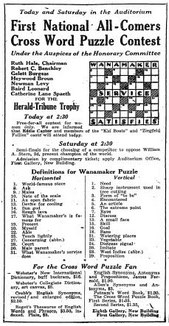
Caitlin Stryker
The first puzzle was created in 1913, crosswords were all the craze in the twenties. At first, only the World carried the puzzles only as a weekly feature and it wasn't until 1924 that the first puzzle book was published and with it the puzzles popularity soared. Soon everything from clothing to jewelry featured crossword puzzles. National competitions were held and wristwatch sized dictionaries were seen all over to make it easier to define words.
(http://www.crossword-puzzles.us/Crossword_Puzzle_History.htm)
The first puzzle was created in 1913, crosswords were all the craze in the twenties. At first, only the World carried the puzzles only as a weekly feature and it wasn't until 1924 that the first puzzle book was published and with it the puzzles popularity soared. Soon everything from clothing to jewelry featured crossword puzzles. National competitions were held and wristwatch sized dictionaries were seen all over to make it easier to define words.
(http://www.crossword-puzzles.us/Crossword_Puzzle_History.htm)
Mah-Jong
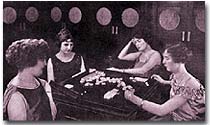
Caitlin Stryker
In the 1920’s, mahjong games were a daily occurance. Not only were friends getting together regularly to engage in this game, but neighbors, strangers and relatives gathered to play as well. Mahjong was so popular that clubs sprung up across the nation. Before men went to work they would drop off their wife at the clubs and pick them up after work. Mahjong let people forget their worries and concentrate on enjoying a game with their friends. This was especially important in the days of the Great Depression but during the twenties, it was simply a fun way to spend time with friends.
(http://otal.umd.edu/~vg/amst205.F96/vj07/project3e.html)
In the 1920’s, mahjong games were a daily occurance. Not only were friends getting together regularly to engage in this game, but neighbors, strangers and relatives gathered to play as well. Mahjong was so popular that clubs sprung up across the nation. Before men went to work they would drop off their wife at the clubs and pick them up after work. Mahjong let people forget their worries and concentrate on enjoying a game with their friends. This was especially important in the days of the Great Depression but during the twenties, it was simply a fun way to spend time with friends.
(http://otal.umd.edu/~vg/amst205.F96/vj07/project3e.html)
Cloche Hat
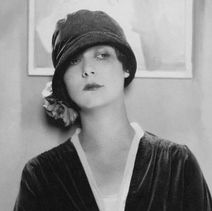
Kelsey Chittum
Cloche hats were worn by flappers during the twenties. They were typically made of felt so they fit closely to a woman’s head. The hats were worn just slightly above the wearer eyes and by the end of the decade; many hats would be flipped up at the brim. Beads and lace were added to the hats in order to make them appropriate for night wear, or even for bridal wear. Cloche hats helped establish the style of a flapper. Along with short hair and a short dress, the cloche hat helped complete the flappers look.
(http://www.fashion-era.com/hats-hair/hats_hair_7_fashion_history_1920_1930.htm)
Cloche hats were worn by flappers during the twenties. They were typically made of felt so they fit closely to a woman’s head. The hats were worn just slightly above the wearer eyes and by the end of the decade; many hats would be flipped up at the brim. Beads and lace were added to the hats in order to make them appropriate for night wear, or even for bridal wear. Cloche hats helped establish the style of a flapper. Along with short hair and a short dress, the cloche hat helped complete the flappers look.
(http://www.fashion-era.com/hats-hair/hats_hair_7_fashion_history_1920_1930.htm)
Stamp Collecting
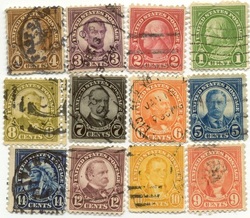
Kelsey Chittum
During the 1920s, stamp collecting was one of the biggest hobbies amongst Americans. Stamp collecting became big, because people started realizing the value of there unused stamps from previous years. This rise in value was due to the fact that some stamps that dated back as early as 1850 were not only saved, but in good condition. Stamp albums were used to place stamps that a person had collected. Some would sell stamps that they had to make a profit, while others bought them, hoping they would rise in value. Most people collected stamps for fun. The excitement of finding a new stamp was the main reason most people did it, which is similar the way people today collect coins. Though there were not many stamps to collect during the twenties, those stamps collected have the highest value than any stamp today.
(http://www.philatelictidbits.com/beginners/the-history-of-stamp-collecting.html)
During the 1920s, stamp collecting was one of the biggest hobbies amongst Americans. Stamp collecting became big, because people started realizing the value of there unused stamps from previous years. This rise in value was due to the fact that some stamps that dated back as early as 1850 were not only saved, but in good condition. Stamp albums were used to place stamps that a person had collected. Some would sell stamps that they had to make a profit, while others bought them, hoping they would rise in value. Most people collected stamps for fun. The excitement of finding a new stamp was the main reason most people did it, which is similar the way people today collect coins. Though there were not many stamps to collect during the twenties, those stamps collected have the highest value than any stamp today.
(http://www.philatelictidbits.com/beginners/the-history-of-stamp-collecting.html)
Charelston
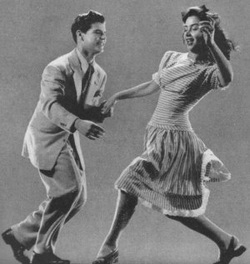
Kelsey Chittum
The Charleston became popular in 1923 after appearing in the Broadway musical Runnin' Wild in 1923. The musical contained a song called the "Charleston" by James P. Johnson, which is how the dance got its name. This dance can be done with a partner, in a group, or by yourself. The dance involves the quick movement of both ones feet and arms. It was one of the first dances, that did not require a great deal of skill, unlike elegant ballroom dancing. The dance went perfect with the fast paced jazz music of the decade.
(http://www.vintageperiods.com/charleston.php)
The Charleston became popular in 1923 after appearing in the Broadway musical Runnin' Wild in 1923. The musical contained a song called the "Charleston" by James P. Johnson, which is how the dance got its name. This dance can be done with a partner, in a group, or by yourself. The dance involves the quick movement of both ones feet and arms. It was one of the first dances, that did not require a great deal of skill, unlike elegant ballroom dancing. The dance went perfect with the fast paced jazz music of the decade.
(http://www.vintageperiods.com/charleston.php)
Miss America

Kelsey Chittum
In an effort to sell more newspapers, nine newspapers along the East Coast sponsored a contest. The contest was looking for the most beautiful women in Philadelphia. The contests would be judged on personality and social grace. The winners, or as they were refereed, "Inner-city Beauties," would win an all expense paid trip to Atlantic City's Second Annual Fall Frolic. Fifty percent of the vote was based off of audience applause, and the second half was based off of the judges decision after meeting each girl individually. Margaret Gorman was the crowned the Inner-city Beauty in 1921. By 1922 the contest had gotten so much recognition and applicants from all over the nation that the contest became known as Miss America.
(http://www.missamerica.org/our-miss-americas/1920/review.aspx)
In an effort to sell more newspapers, nine newspapers along the East Coast sponsored a contest. The contest was looking for the most beautiful women in Philadelphia. The contests would be judged on personality and social grace. The winners, or as they were refereed, "Inner-city Beauties," would win an all expense paid trip to Atlantic City's Second Annual Fall Frolic. Fifty percent of the vote was based off of audience applause, and the second half was based off of the judges decision after meeting each girl individually. Margaret Gorman was the crowned the Inner-city Beauty in 1921. By 1922 the contest had gotten so much recognition and applicants from all over the nation that the contest became known as Miss America.
(http://www.missamerica.org/our-miss-americas/1920/review.aspx)
Smoking
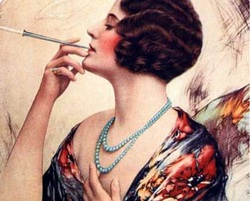
Bryanna Chrisp- In the 1920's, as a direct result of the passing of the Sherman Anti-trust Act, the American Tobacco Trust severed into various tobacco companies. As these companies struggled to maintain financial stability, and economic competition intensified, these companies utilized media to depict their products as fashionable. (See left, where an attractive woman is portrayed smoking). Men began to transfer from smoking cigars to cigarettes. To women, whom had in the same decade been empowered with the right to vote and had begun to express independence and rebellion from society's traditional expectations of females, smoking had become a political statement, and a popular trend.
(enotes.com) (vintageadbrowser.com)
(enotes.com) (vintageadbrowser.com)
Jitter Bug
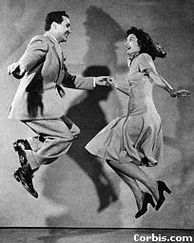
Paul Hwang
The jitter bug, also known as the "hop" became popular in the 1920's. It became the preferred and popular dance, but most in Harlem. Later on in 1927 the "hop" became the "Lindy"in the savoy ballroom, said to be name after Lindbergh's famous flight across the Atlantic. The jitter bug came from how the dance would be done. The jitter bug is done with several movements with the feet, hips, heads, and hands. The dance would be done with skips, hops, and jumps. (http://www.bobethomas.com/history/history_lindy.htm)
The jitter bug, also known as the "hop" became popular in the 1920's. It became the preferred and popular dance, but most in Harlem. Later on in 1927 the "hop" became the "Lindy"in the savoy ballroom, said to be name after Lindbergh's famous flight across the Atlantic. The jitter bug came from how the dance would be done. The jitter bug is done with several movements with the feet, hips, heads, and hands. The dance would be done with skips, hops, and jumps. (http://www.bobethomas.com/history/history_lindy.htm)
Listening to the radio
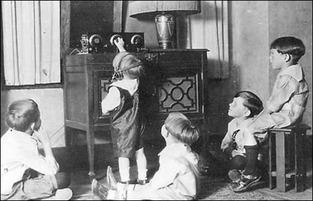
Paul Hwang
Radio programs started to broadcast during the 1920's. The broadcasting program was called KDKA. Majority of the population could not hear the voices or songs due to the radio receivers at that time. The radio was still a hit to the public, and sixty percent of the public would have a radio in their homes. Later on during the 1923 the radio would be more improved and would be more clear to hear.
(http://xroads.virginia.edu/~ug00/3on1/radioshow/1920radio.htm)
Radio programs started to broadcast during the 1920's. The broadcasting program was called KDKA. Majority of the population could not hear the voices or songs due to the radio receivers at that time. The radio was still a hit to the public, and sixty percent of the public would have a radio in their homes. Later on during the 1923 the radio would be more improved and would be more clear to hear.
(http://xroads.virginia.edu/~ug00/3on1/radioshow/1920radio.htm)
Miniature Golf
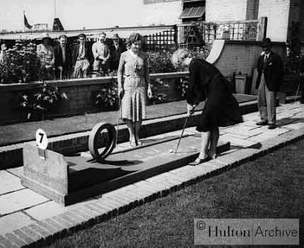
Paul Hwang
Golf is a sport of the past during the 1920's. Miniature golf is the new hip sport. No longer is a spacious course necessary, because a small challenging course is now available to public. Miniature golfing is similar to the sport Golfing, but is different in size. Not only is the size different, but also the course design. The course is filled with obstacles, such as twists and turns. Miniature golfs became popular in fairs and in parks. Miniature golfing would be a unisex and ageless sport.
(http://www.terrastories.com/bearings/miniature-golf)
Golf is a sport of the past during the 1920's. Miniature golf is the new hip sport. No longer is a spacious course necessary, because a small challenging course is now available to public. Miniature golfing is similar to the sport Golfing, but is different in size. Not only is the size different, but also the course design. The course is filled with obstacles, such as twists and turns. Miniature golfs became popular in fairs and in parks. Miniature golfing would be a unisex and ageless sport.
(http://www.terrastories.com/bearings/miniature-golf)
Gambling
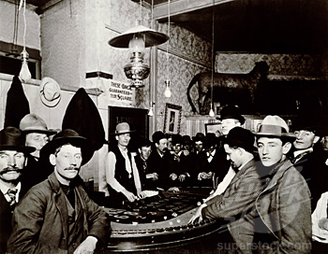
Paul Hwang
Gambling will soon take over America in the 1920's. From Government officials to well known gangsters. Gambling will become addicting like alcohol, and dangerous like drugs. Gambling would lead to chaos and crimes. When gambling with money is mixed in with bootlegged alcohol, drugs, anger, and gangsters bad events are bond to happen. During the 1920's Al Capone would make his money off bootlegging, and gambling.
(http://www.scribd.com/doc/93382/1920s-Terms)
Gambling will soon take over America in the 1920's. From Government officials to well known gangsters. Gambling will become addicting like alcohol, and dangerous like drugs. Gambling would lead to chaos and crimes. When gambling with money is mixed in with bootlegged alcohol, drugs, anger, and gangsters bad events are bond to happen. During the 1920's Al Capone would make his money off bootlegging, and gambling.
(http://www.scribd.com/doc/93382/1920s-Terms)
Dance Marathons
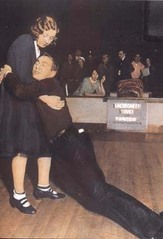
Andrew Ramirez
Dance marathons were endurance contests were couples competed for cash prizes of $100 or $1000. Te marathons typically lasted for a couple months. The public could watch the competitors for an admission fee of 25 cents. Promoters of that time called them walkathons since it was a less threatening term since churches at that time thought dancing was a sin.
(http://www.historylink.org/index.cfm?DisplayPage=output.cfm&file_id=5534)
Dance marathons were endurance contests were couples competed for cash prizes of $100 or $1000. Te marathons typically lasted for a couple months. The public could watch the competitors for an admission fee of 25 cents. Promoters of that time called them walkathons since it was a less threatening term since churches at that time thought dancing was a sin.
(http://www.historylink.org/index.cfm?DisplayPage=output.cfm&file_id=5534)
Toasters
-Zachary Brown-
The first automatic pop-up toaster made for at home use was made in 1926, the Toastmaster 1-A-1, but it was an expensive luxury, that most people couldn't afford and manual toasters continued to be manufactured and sold in the U.S. well into the 1950s.
(http://www.toaster.org/index.html)
The first automatic pop-up toaster made for at home use was made in 1926, the Toastmaster 1-A-1, but it was an expensive luxury, that most people couldn't afford and manual toasters continued to be manufactured and sold in the U.S. well into the 1950s.
(http://www.toaster.org/index.html)
Liquid Fuel Rocket
-Zachary Brown-
The Liquid Fuel Rocket was developed in 1926, by Robert Goddard. He developed two of the main rocket designs which today are regarded as milestones in space flight. One of them was the multi-stage rocket and the second one, was the liquid fuel rocket.
(http://www.innovateus.net/content/rocket)
The Liquid Fuel Rocket was developed in 1926, by Robert Goddard. He developed two of the main rocket designs which today are regarded as milestones in space flight. One of them was the multi-stage rocket and the second one, was the liquid fuel rocket.
(http://www.innovateus.net/content/rocket)
Musicals
-Zachary Brown-
The 1920s were Broadway's busiest decade, with as many as fifty new musicals opening in a single season. Large amounts of people forked over up to $3.50 a seat. Some of the famous musicales of the time included: Sunny (1925), Rosalie (1928), No, No, Nanette (1925), The Three Musketeers (1928), and The Desert Song (1926).
(http://www.musicals101.com/1920bway.htm)
The 1920s were Broadway's busiest decade, with as many as fifty new musicals opening in a single season. Large amounts of people forked over up to $3.50 a seat. Some of the famous musicales of the time included: Sunny (1925), Rosalie (1928), No, No, Nanette (1925), The Three Musketeers (1928), and The Desert Song (1926).
(http://www.musicals101.com/1920bway.htm)
Built-in furniture
-Zachary Brown-
Homes with Built-in Furniture became popular between 1900 and 1930, being especially popular in the 1920's. Built-in Furniture became popular ecause they saved space, increased efficiency and provided maximum storage, as well as because they were easy to clean.
(http://www.fromtimespast.com/homes/TheComfortableHome-BuiltinFurniture.htm)
Homes with Built-in Furniture became popular between 1900 and 1930, being especially popular in the 1920's. Built-in Furniture became popular ecause they saved space, increased efficiency and provided maximum storage, as well as because they were easy to clean.
(http://www.fromtimespast.com/homes/TheComfortableHome-BuiltinFurniture.htm)
Flag pole sitting

Andrew Ramirez
In the mid-1920s flag pole sitting became popular among the young masses. It kept the people entertained since there wasn't really anything else to do. Pole-sitting is related to the ancient ascetic discipline of Stylitism, or column-sitting. Alvin Kelly a.k.a Shipwreck Kelly was the most famous flag pole sitter who sat on a pole for 49 days!
(http://hubpages.com/hub/Hey-Whatcha-Doin-Up-There-Nuttin-Jes-Sittin)
In the mid-1920s flag pole sitting became popular among the young masses. It kept the people entertained since there wasn't really anything else to do. Pole-sitting is related to the ancient ascetic discipline of Stylitism, or column-sitting. Alvin Kelly a.k.a Shipwreck Kelly was the most famous flag pole sitter who sat on a pole for 49 days!
(http://hubpages.com/hub/Hey-Whatcha-Doin-Up-There-Nuttin-Jes-Sittin)
Hood Ornaments
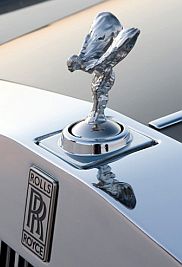
Andrew Ramirez
Hood ornaments started out because the owners of a with an engine thermometer wanted to make it look fancy. Over time they added decorative ornaments. In the 1920s there was no need for the motometer so the hood ornaments were just for show.
(http://www.discounthoodornaments.com/history)
Hood ornaments started out because the owners of a with an engine thermometer wanted to make it look fancy. Over time they added decorative ornaments. In the 1920s there was no need for the motometer so the hood ornaments were just for show.
(http://www.discounthoodornaments.com/history)
Peter Pan Peanut Butter
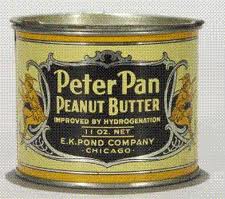
Andrew Ramirez
Peanut butter has been around for hundreds of years but in in 1922, Joseph L. Rosefield began selling a number of brands of peanut butter in California and received the first patent for a shelf-stable peanut butter which would stay fresh for up to a year because the oil didn't separate from the peanut butter. In 1928 Peter Pan Peanut Butter popularized peanut butter.
(http://www.peanutbutterlovers.com/history/index.html)
Peanut butter has been around for hundreds of years but in in 1922, Joseph L. Rosefield began selling a number of brands of peanut butter in California and received the first patent for a shelf-stable peanut butter which would stay fresh for up to a year because the oil didn't separate from the peanut butter. In 1928 Peter Pan Peanut Butter popularized peanut butter.
(http://www.peanutbutterlovers.com/history/index.html)
